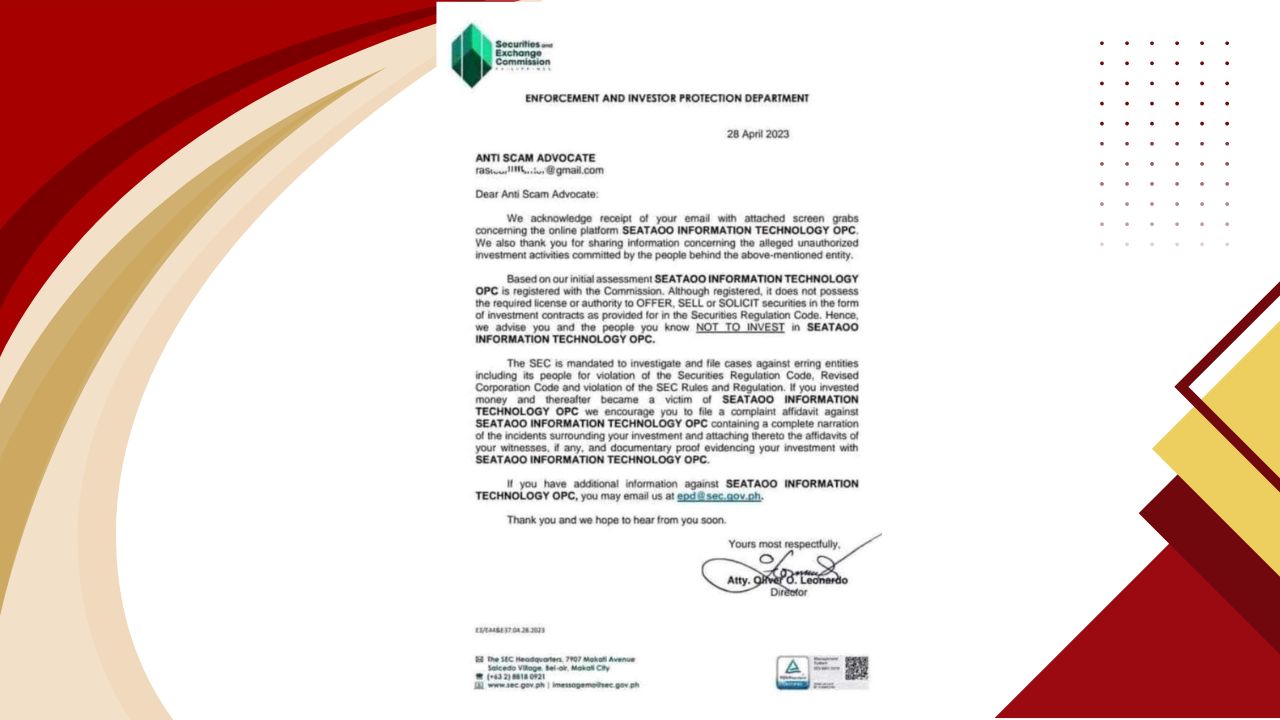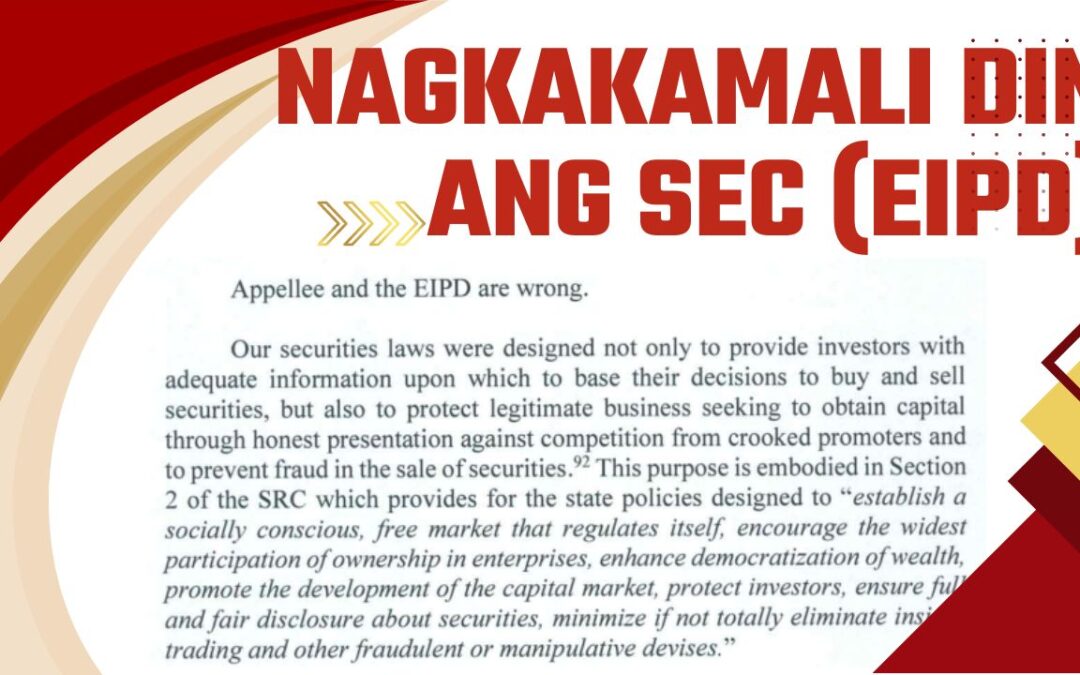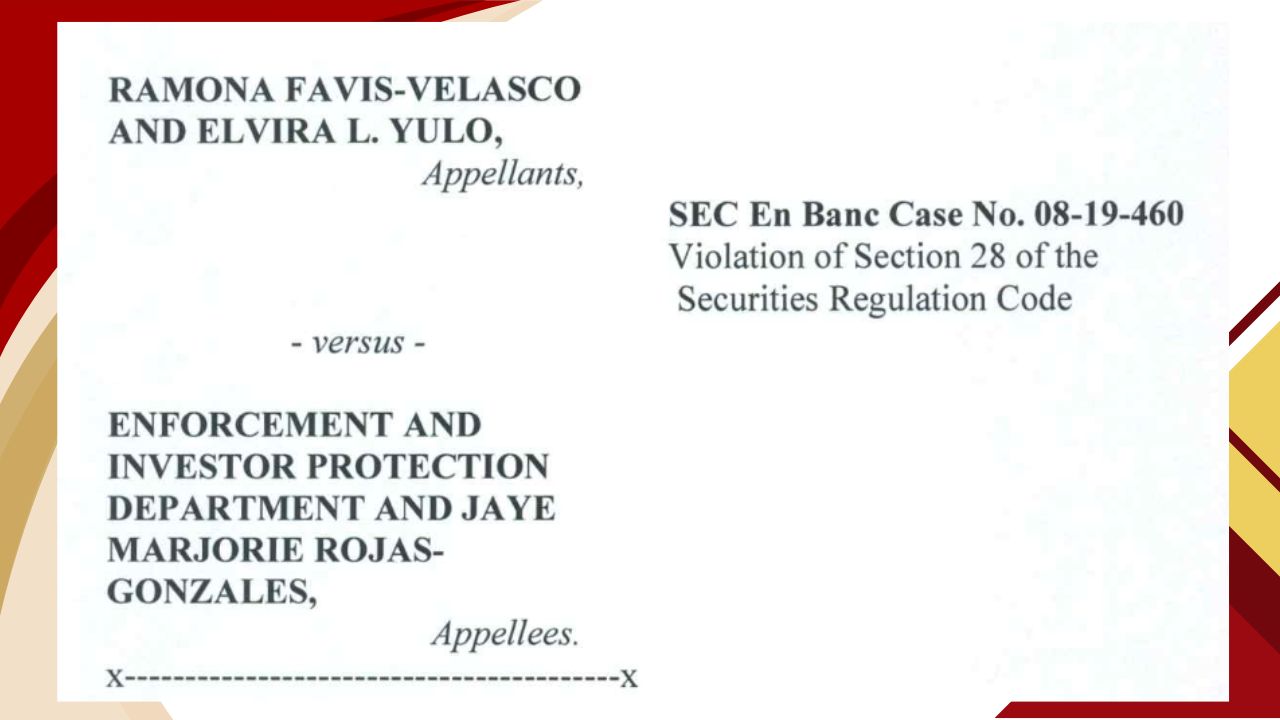Challenging SEC Decisions: “No One is Above the Law in Regulatory Actions”
No one is above the law, and this principle applies equally to individuals, corporations, and government agencies alike. Even quasi-judicial agencies like the Securities and Exchange Commission (SEC) can be subject to scrutiny and challenge when their decisions appear to be based on incomplete or unverified information. In the case of New Seataoo Corporation, the SEC issued a Revocation Order based on allegations from anonymous sources without first conducting thorough investigations or obtaining firsthand evidence. This decision, made without hearing the side of the company or legitimate sellers, raises concerns about the fairness and due process in regulatory actions.
The principle of fairness demands that all parties involved in a dispute have the opportunity to present their case before a decision is made. In this instance, New Seataoo Corporation was not given the chance to defend itself against the accusations that led to the SEC’s Revocation Order. The absence of a comprehensive investigation, coupled with the reliance on unverified reports, suggests that the SEC may have acted prematurely or without sufficient basis. This highlights the importance of due diligence and the need for regulatory bodies to ensure that their actions are supported by concrete evidence and fair procedures.
Decisions made by government agencies, including the SEC, are not infallible and can be reversed or set aside if found to be flawed. The case of New Seataoo Corporation serves as a reminder that even the highest authorities are accountable for their actions and must adhere to the principles of justice and fairness. When a decision is based on incomplete information or procedural missteps, it is not only subject to challenge but also reversible upon review by the appropriate judicial or appellate bodies. This underscores the essential role of the legal system in safeguarding the rights of individuals and corporations against potential overreach by regulatory agencies.
Nakatanggap ng Report or Letter ang SEC from Anti-Scam Advocate
Noong 2023 ay nakatanggang ng letter ang Securities and Exchange Commission ng sulat na hindi naman ipinakita at sinabi na ang sulat ay notaryado, an ordinary letter coming from the Anti-Scam Advocate.
 Ang sulat ay mula sa grupo ni Ciemny Aniol na ang layunin ay ipaalam sa Securities and Exchange Commission ang mga activities na ginagawa ng Seataoo Information Technology OPC na kung ating iintindihin ay inirereport ng kanyang grupo na ang SEATAOO do OFFER, SELL, SOLICIT Securities in the From of Investment contracts as provided for the Securities Regulation Code.
Ang sulat ay mula sa grupo ni Ciemny Aniol na ang layunin ay ipaalam sa Securities and Exchange Commission ang mga activities na ginagawa ng Seataoo Information Technology OPC na kung ating iintindihin ay inirereport ng kanyang grupo na ang SEATAOO do OFFER, SELL, SOLICIT Securities in the From of Investment contracts as provided for the Securities Regulation Code.
MY OPINION
Base sa sagot ng Director na si Atty. Oliver O. Leonardo, ang mga sinubmit na mga patunay o proof ng grupo ng Anti-Scam Advocate ay mga SCREEN GRAB o kinuhang mga screenshot sa iba’t ibang mga Social Media Platform.
Legal naman ang mga SCREENSHOTS at maaaring gamiting ebidensya, subalit ang mga katulad na ebidensya ay may mga guidelines na dapat sundin.
Bagamat mandated ang SEC to Investigate and File Cases against erring entities including its people for for violation of the Securities Regulation Code, Revised Regulation Code, and Violation of the SEC Rules and Regulation…..
LAGING nakalagay sa kanilang mga sulat or response…. WE ENCOURAGE YOU TO FILE A COMPLAINT-AFFIDAVIT against Seataoo Technology OPC containing a complete narration of the of the incidents surrounding your investment and attaching thereto the affidavits of your witnesses.
- Valid and Verified ba ang mga Screenshots or Screengrabs?
- Ang grupo ba ng Anti-Scam Advocate ay may FORMAL AFFIDAVIT-COMPLAINT?
- May sapat bang mga ebidensya ang Anti-Scam Advocate?
- My mga witnesses ba ang Anti-Scam Advocates?
Those are are the questions na kailangang sagutin at ipaliwanag ng Securities and Exchange Commission particular na ng EIPD. Sapagkat lagi nilang sinasabi na para mag-umpisang gumalaw ang kanilang mandato, kinakailangang mayroong formal complaint. BUT hindi malinaw sa kanilang sagot at hindi binanggit ng SEC kung formal ba ang reports na kanilang natanggap mula sa Anti-Scam Advocate.
Bilang Seller, noong mga nakaraang buwan o linggo ay nagpapadala ako ng email, ng sulat na hindi naman formal kaya hindi ako nakakakuha sa kanila ng mga sagot sa aking katanungan. Ibig sabihin, para mapanigan at masagot ang aking mga katanungan, dapat ay mag-file muna ako ng FORMAL COMPLAINT.
Noong nag-file ako ng FORMAL COMPLAINT, ay hindi na ako nakatanggap ng kasagutan mula sa ahensya. Ano kaya ang itinatago ahensya?
Utilizing Digital Evidence in Legal Complaints in the Philippines
Query: Can I attach screenshots of a group chat where I was bullied as part of a complaint letter?
In the context of the Philippines, the admissibility of digital evidence, including screenshots, is governed under the Rules on Electronic Evidence (A.M. No. 01-7-01-SC). According to these rules, electronic documents such as screenshots are considered as admissible evidence provided they meet certain criteria of authenticity, reliability, and relevance.
Guidelines for Using Screenshots as Evidence:
- Authenticity: To be admissible, it must be demonstrable that the electronic document is what it claims to be. This involves confirming that the screenshots have not been altered and originate from the sources they claim to represent.
- Reliability: The method of capturing the screenshot must safeguard against alterations or tampering. This includes using software or methods that can provide a timestamp or some form of verification to prove the integrity of the screenshot at the time it was captured.
- Relevance: The screenshots must be directly relevant to the case at hand. They should contribute substantively to a fact in issue or dispute within the legal proceedings.
- Presentation: Screenshots should be presented in a manner that retains their legibility and clarity when printed or viewed in digital format. This may involve providing supporting documentation that explains the context of the screenshots and their significance to the complaint.
Procedure for Attaching Screenshots to a Complaint Letter:
- When preparing to file a formal complaint where electronic evidence is involved, including a declaration or an affidavit that describes how the screenshots were obtained and ensuring that all electronic evidence is attached as annexes to the complaint.
- If you are unsure of the process or the acceptability of your screenshots as evidence, it might be beneficial to consult with a legal professional who can provide guidance on proper procedure and help ensure that your evidence is compiled in a way that will be recognized by the courts.
Considerations for Privacy and Legality:
- It is crucial to ensure that no privacy laws are violated in the process of obtaining screenshots. Unauthorized access to someone else’s electronic communications without their consent can be illegal under certain circumstances.
Conclusion: Attaching screenshots to a complaint letter can be a powerful tool in proving claims of bullying or other forms of electronic harassment. However, it is essential to ensure that these electronic documents meet the criteria set out by Philippine law to be considered valid evidence in any legal proceedings. Proper handling and presentation of this evidence are crucial to support the integrity and credibility of your case.
Maaari bang mabago or ma-reverse ang Decision ng SEC?
Sa Ramona Favis-Velasco and Eliva L. Yulo vs. Jay Marjorie Roxas Gonzales. SEC En-Banc Case Number 08-19-460 ay na reversed at na set-aside ang naging decision ng SEC.



In my opinion this is a better course of action we (sellers) must take. SEC must hear the sellers side explaining and understanding clearly how the entire Seataoo operation goes. If we can give jusrifiable reason that Seataoo is not soliciting from us in the form of an investment then we have a better chance to appeal for a reversal of the revocation order.
SEC only listen to the reports they have received from Anti-Scam Advocate. They didn’t consider talking or requested conference with Sellers.
Challenging SEC Decisions: No One is Above the Law in Regulatory Actions
As far as I am concerned no solicitation in any form of investment were asked by Seataoo.Corporation. And that on June 10,2024 I was shocked that the SEC issued revocation order for Seataoo Corporation.
Now ko lang nkita yung affidavit na yan..grabe pala nakalagay..puro investment nabasa ko..pinagpipilitan nila investment..e hindi nga..ang hirap nila paliwanagan..naglagay ka nga ng pera sa app kaya investment tingin nila, di nila magets na yung nilagay mo capital yun at ikaw ang nagmamanage dun..kung hindi ka mag process ng orders nandun lang yun widrawable yun..kagaya lang ng gcash, gotyme, online bank, digital bank, pag naglagay ba tayo dun investment na bang matatawag yun???..same sa seataoo naglagay ka sa wallet balance mo..di ka nag invest..yung pera mo sa gcash pede ka bumili sa lazada sa shopee magload magbayad bills etc..sa seataoo wb naman pede ipang bili din ng seataoo items, pede rin icapital sa shop na ginawa mo, ayun ang napakagndang features ng app na yun marami natulungan, sobrang gandang innovation ng technology na di ma gets ng mga matatandang empleyado ng sec..wala alam sa innovation..para sa kanila pag naglagay ng pera INVESTMENT na agad yun…baka wala sila mga digital wallet..alam kaya nila katulad sa gcash app na maraming pedeng gawin dun? Dahil hitech na ngayon..alam kaya nila na bukod sa lagayan ng pera at pa load at paybills, ay pde rin dun mag load ng rfid,kumuha ng insurance any kind of insurance name it,makapagtanim ng puno,makapagsugal,makapagloan,makapagenrol,makapapagnegosyo,makapagcrypto,mag games, magshopping, at marami pang iba na sa tingin ko di alam ng matatandang nasa sec..so pag tayo nag lagay ng pera sa gcash matatawag na bang investment yun???? Kasi pinipilit nila na investment si seataoo kasi naglagay tayo pera sa app nila..e napakaraming digital wallet bat nila single out si seataoo? Dahil ba kumikita tayo? Sana kasi nag deep dive sila at di naniwala sa mga sabi sabi..di daw totoo ang naorder sabi ng basher..e nakailang order na ko ng product nila..di lang ako madami kahit nasa ibang bansa nakakarating ang order..marami nag try para ma prove na totoong tao ang omorder..yung si aniol anu ba proof nya na pinakita? Omorder ba sya tapos hindi dumating? Ganun ba? May kahit isang seller ba noon na nagsabi na na scam sila? Kung sino pa yung hindi seller yun pa ang pinaniwalaan nila..nakakapu@@@@ talaga..
Si Dylan di yan pinoy kaya underdog yan..di nya alam kultura sa phil govt..dapat may padrino at padulas..kaya if wala tutulong sa knya mababalewala ang appeal na yan..sana magpatulong sya..pero panu nga sya magpapatulong e mismong mga seller na natulungan nya bumaliktad na..yung dating mahal na mahal sya ngayon nilalaglag na rin sya..so sino ang pagkakatiwalaan nya..pede nga syang di na mag update at magparamdam eh kasi ganun din naman di madisburse pera kasi blacklisted, yung appeal delaying tactics ni sec nag iintay ng mas malaking settlement yan kasi if not bat revocation pa binaba nila kung scammer pala, edi sana ceast and desist na diba, tuldukan na nila..e bat ndi diba, waiting sila padulas mga kuratong talaga!!! Sa tingin ko jan obvious naman na hugas kamay sec na yan, ang gara ng affidavit talaga puro investment wordings nila..mga seller mag isip isip kayo na gagamit ng affidavit na yan..yan na magiging katapusan naten..dapat magkaisa ang seller at ang seataoo, idiin at balikan ang sec na yan..maipantindi sa kanila ang bagong technology ngayon..pag naipantindi sa knila yan at naintindihan nila only then pede ma lift ang revication at matuloy ang business nateng lahat..WAG TAYONG MAGPAGAMIT SA MAKIKITID AT KINULANG ANG PAG IISIP AT MAPAGSAMANTALA…madami pa ko pov pero next time na uli need ko mag work na dahil pera ko naipit pa sa seatoo buset yang SEC na yan..mga lumang tao..dapat palitan na ng mga batang matatalino..ang bob@ eh.. tsktsk
possible solutions or actions to discuss
Hi Sir,
1. Quit Claim
2. Motion for Reconsideration
Dear Seataoo and SEC,
Please be fair and just to us
seller’s. We need our funds to be
returned as soon as possible.
Agree to the conclusion.
The burden of proof lying with the accuser is a fundamental principle designed to protect individuals’ rights and ensure fairness in legal proceedings. It reflects the notion that it is better for the guilty to go free than for the innocent to be wrongly convicted.
Kung ang Quit Claim at Motion for Reconsideration ang pinaka magandang paraan para sa hinaharap natin problema
sana umabot sa senate
Dapat lamang na tugma ang pag aksyon ng SEC sa pag bawi ng lisenya sa Seataoo dun sa pag bawi din sana ng pera para ito ay maibalik o maipamahagi sa mga lihetimong sellers ng Seataoo. Kami n mga nasa ibang panig ng daigdig ay lubos na nanganfanba sapagkat walang malinaw deriksyon kung panu nmin mababawi ang perang hanggang ngayon ay nasa Seataoo pa rin
Sa sec talaga Ang problema KaSi naniwala sa report at Isa lng pinapanigan Ang the best sulotion matanggal Ang revocation pero ano Ang gagawin natin parang ginigisa Tayo Ng sec para maidiin si SeatAoo na scam paano wala naman Tayo evedence KaSi noong wala pa revocation ok na ok Ang seataoo
SEC revocation be reversed as per “Onus Probandi” principle to the Seataoo Corporation.
Correct SEC legal kami mga seller wala kami nilabag na batas dahil din sa ahinsiya ninyo kaya kami nakapag join din sa Seataoo. Naturingan Security asan ngayon kami mga inosente gusto kumita ng maayos. Kong ganyan pamantayan nyo Alisin nyo na ang work na Security sa exchanges nalang at commision
Seataoo is not an investment! SEC be fair!!! Dahil sa inyo nagtiwla kami sa company.Before ng revocation napaka smooth ng withdrawal transaction at never kami ngkaproblem. 2years niyo binigyan ng Lincense and now sasabihin niyong investment and scam dahil lang sa report ng ilang seller na naninira sa platform.Sana nag investigate muna kayo sa mga legit seller! Until now bulok pa rin goverment agency ng pinas. Inipit niyo ang mga seller.